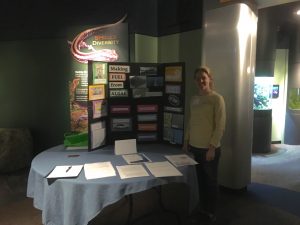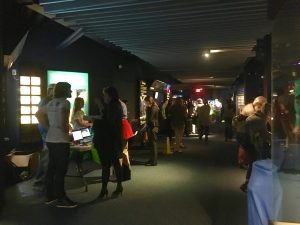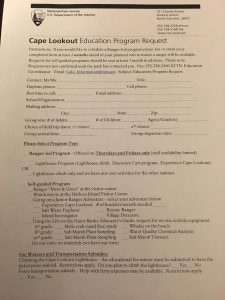Next to an exhibit of salamanders, I neatly arranged my lesson plan papers on a table, set up my contact sheet with a pen nearby and propped up my tri-fold display titled “Making Fuel from Algae.” I braced myself for an evening of talking to many educators from across eastern North Carolina – something that would usually leave me exhausted.

But instead, after talking to numerous groups of educators of every grade level, I felt invigorated. Apparently I had underestimated the “coolness” factor of my research topic (move over, drones). Educators were genuinely curious and excited about algal biofuels and my lesson plan, which in turn excited me and nourished my commitment not only to STEM education and outreach but also to my own work. When things are not going very well in lab, and you’ve just spent hours looking at small things under a microscope, it can be refreshing to step up to a much broader level of your research to share with others.

This event I attended on Feb. 16 is called SciREN Coast, and is organized by a group of graduate students from the UNC Institute of Marine Science and the Duke Marine Lab. The North Carolina Aquarium at Pine Knoll Shores has been hosting the event annually for the past 5 years. SciREN (the Scientific Research and Education Network) links researchers and local educators to facilitate the dissemination of current research in K-12 classrooms and other educational outlets. Researchers design lesson plans related to their own work and share these with educators at SciREN events. Educators and researchers can network and plan classroom visits, and educators can register for the SciREN Portal to gain access to all of the lesson plans. Prior to these events, researchers can also attend a lesson plan workshop to learn about required standards and gain advice from educators themselves.

My own lesson plan has students synthesize data from published maps, figures and tables to make decisions about how to design their own algae cultivation facilities. For example, they are asked to choose the location of their facility, a water source for their algae and the type of algae they’ll grow. Links to all of my lesson materials are at the bottom of this post.
I previously presented this lesson plan at the SciREN Coast event in 2015 (fortunately for me there were many new educators at SciREN this year). Since then, I’ve led this lesson with two classes of 8th grade students in the Duke TIP summer program. When students are given roles as managers of their fictitious algae biofuel companies, they take greater responsibility for thinking through their decisions and using all the information available. They especially like to compete to see whose company will likely be the most profitable.

In addition to talking to educators, I also had the opportunity to talk with several other researchers and lesson-plan developers from UNC, East Carolina University, the National Park Service and even Duke (there are always new people to meet). For example, I learned that Cape Lookout National Seashore offers lesson kits for student groups to borrow on their trip to Cape Lookout, which I may take advantage of in the future.

SciREN has grown in numbers and locations since its founding five years ago. As long as there are researchers willing to step into the shoes of educators to create their own lesson plans, there will be lasting connections between educators and scientists for years to come.
Materials for “Design Your Own Algae Biofuel Company” lesson plan:

